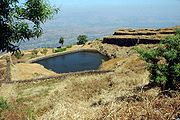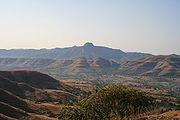
Rajgad
Encyclopedia

Maharashtra
Maharashtra is a state located in India. It is the second most populous after Uttar Pradesh and third largest state by area in India...
state in India
India
India , officially the Republic of India , is a country in South Asia. It is the seventh-largest country by geographical area, the second-most populous country with over 1.2 billion people, and the most populous democracy in the world...
. Situated in the Pune
Pune
Pune , is the eighth largest metropolis in India, the second largest in the state of Maharashtra after Mumbai, and the largest city in the Western Ghats. Once the centre of power of the Maratha Empire, it is situated 560 metres above sea level on the Deccan plateau at the confluence of the Mula ...
district, the fort is approximately 1326 meters above sea level.
Formerly known as Murumdev, it was capital of the Maratha Kingdom (Hindavi Swarajya) ruled by Chhatrapati Shivaji Maharaj for almost 26 years, after which he moved to Raigad fort and made that his capital.
Treasure found on adjacent Torna Fort
Torna Fort
Torna Fort or Prachandagad is a large fort located in Pune district in the state of Maharashtra, India. It is historically significant because it is the first fort captured by Shivaji in 1643, forming the nucleus of the Maratha empire. The hill has an elevation of 1405 mts. above sea level, making...
was used to fortify this hill.
Location
The fort is 42 km to the south west of Pune, about 15–16 km west of Nasrapur, in the Sahyadris range.The fort can be divided into four different parts based on geographical terrain and fortification. These are the three sub-plateaux (Machee) namely Padmavati Machee, Suvela Machee and Sanjeevani Machee, and the central volcanic plug
Volcanic plug
A volcanic plug, also called a volcanic neck or lava neck, is a volcanic landform created when magma hardens within a vent on an active volcano. When forming, a plug can cause an extreme build-up of pressure if volatile-charged magma is trapped beneath it, and this can sometimes lead to an...
called Balekilla (meaning "small fort" or "citadel").

Padmavati Machee (north end)
This machee is the site of Padmavati Temple, Padmavati Lake, Chor Darwaja, Pali Darwaja, Gunjavane Darwaja, Daru Kothar (storage of arms and ammunition), Diwankhana, Rajwada (ruins), Ghod Tale (Horse Lake), Sadar (office) and Dhalkathi (flag hoisting place)..It is also a site of Samadhi (Tomb) of King Shivaji's first wife, Saibai..Sanjeevani Machee (southwest/west end)
The machee faces west and has a three-stepped (layered) fortified structure. Each of the lower levels is separated from the higher one by a fortified bastion with a gate that could be defended independently. The lowest level is fortified by double curtain walls (chilkhathi) separated by a deep trench, on average 12 feet across. One can walk between these walls. The outer wall has openings to let soldiers out for sudden attack.
Suvela Machee (south east)
This is another machee facing east with lots of secret routes and doorways. This one is a double-stepped fortified machee with the steps separated by a bastioned doorway. At the end of first step a hole cuts across the rock; one can sit on this hole (nedhe).The final (lowest) step like Sanjeevani Machee is has a double curtain wall.
To the south side of this machee there is a triangular bastion called Kaleswari buruz having an escape door near it. The home of the renowned military leader Tanaji Malusare
Tanaji Malusare
Tanaji Malusare , also known as Simha , was a warrior and military leader in the army of Shivaji, founder of the Maratha Empire in 17th century India. Tanaji was one of Shivaji's closest friends; the two had known each other since childhood....
was in this machee.
Bale Killa (centre)
This is the highest part of the fort which has remains of palaces, water cisterns and caves. It has an entrance door called Mahadarwaja. One can view the whole fort and the vast surrounding expanse.Surrounding hills

Sinhagad
Sinhagad, Sinhgarh, or Sinhgad , is a fortress located roughly 30 kilometres southwest of the city of Pune, India. Previously called Kondhana , the fort has been the site of many important battles, most notably the battle of Sinhagad in 1670...
with its marked television tower. To the west lie Torna Fort
Torna Fort
Torna Fort or Prachandagad is a large fort located in Pune district in the state of Maharashtra, India. It is historically significant because it is the first fort captured by Shivaji in 1643, forming the nucleus of the Maratha empire. The hill has an elevation of 1405 mts. above sea level, making...
, the pinnacle fort Lingana and, down in Konkan
Konkan
The Konkan also called the Konkan Coast or Karavali is a rugged section of the western coastline of India from Raigad to Mangalore...
, Raigad.
To the east one can see the twin forts of Purandar
Purandar fort
Purandar fort पुरंदर किल्ला figures repeatedly in the rising of Shivaji against the Bijapur kingdom and the Mughals. Purandhar fort stands 4,472 ft. above the sea in the Western Ghats, 20 miles southeast of Pune. It actually consists of two forts - Purandar and Vajragad...
and Vajragad (Rudramal).
To the south east one can locate Rohida
Rohida
Rohida is a village in Sirohi district of Indian state of Rajastan.Rohida is birth place of the historian Gaurishankar Hirachand Ojha. In 1922 Motilal Tejawat organized Eki Movement to unit tribals at Rohida.- References :***...
. To the south are Kenjalgad and Raireshwar
Raireshwar
Raireshwar is situated in Bhor Taluka near Pune, India. Raireshwar has a temple famous for its historical importance. The temple is very old and of stone structure, uut it was later re-constructed in 18th century. Chhatrapati Shivaji Maharaj took the oath of Hindavi Swarajya in this temple at the...
plateau at a distance Mahabaleshwar
Mahabaleshwar
Mahabaleshwar is a city and a municipal council in Satara district in the Indian state of Maharashtra. It is a hill station located in the Western Ghats range. With one of the few evergreen forests of the world, it served as the summer capital of Bombay province during the British Raj.-Geography...
(seen through the "W" of Kaleshwar plateau range behind Raireshwar.)
History
This fort is built on the hill called "Murumb Devacha Dongar"Rajgad boasts the highest number of days stayed by Chhatrapati Shivaji Maharaj on any fort.
This fort has witnessed lots of historic events, including the birth of Rajaram Chhatrapati, the death of Shivaji's Queen Saibai, the return of Shivaji from Agra, the antyayatra of Tanaji Malusare
Tanaji Malusare
Tanaji Malusare , also known as Simha , was a warrior and military leader in the army of Shivaji, founder of the Maratha Empire in 17th century India. Tanaji was one of Shivaji's closest friends; the two had known each other since childhood....
to his Konkan village, the burial of Afzal Khan's head in the Mahadarwaja walls of Ballekilla, the strict words of Sonopant Dabir to Shivaji, and the Khandoji Khopade episode.
The diameter of the fort at the base is 40 km making it difficult for anybody to lay siege to it.
List of chronological events:
A.D 1490: Ahmed Bahiri Nijamshah captured the fort.
A.D 1626: During the Nizam's last struggle, Adilshah captured the fort.
A.D 1630: Due to Shahajiraje, fort was again captured by Nizamshahi.
A.D 1642: This fort was included in Shahajiraje's jagir.
A.D 1647: Shivaji Maharaj captured the fort
A.D 1649: The repairing of the fort started and Shamrao Neelkanth Ranzekar was appointed as the Prime Minister of Swaraj.
A.D 1652: The administration of Swaraj was started.
A.D 1654: New type of fortification's and other buildings' construction was started. The fort renamed as 'Rajgad'.
A.D 14 January 1658: After conquering North Konkan, Maharaj returned to Rajgad.
A.D 11 July 1659: To fight Afzalkhan, Maharaj shifted to Pratapgad.
A.D 5 September 1659: Saibai's(Shivaji Maharaj's wife) death on the fort.
A.D 1660: To raise Siddi Jouhar's siege, Jijamata started with the army but actually Netaji Palkar and Siddi Hilal were sent.
A.D July 1660: Maharaj escaped from Siddi Jouhar's siege, came to Vishalgad and then to Rajgad.
A.D July 1661: The idol of Bhavanimata, which was to be established in Pratapgad, was first brought to Rajgad for Jijamata's sight.
A.D January 1662: The construction of the fort is completed and Maharaj returned to the fort after capturing Pen and Kalyan.
A.D 6 April 1663: After Shaistakhan's raid, Maharaj went to Kondana and then to Rajgad.
A.D February 1664: The booty of Surat was brought to Rajgad.
A.D 30 April 1665: The unsuccessful attack of the Mughals on the fort.
A.D June 1665: Shivaji Maharaj's letter of accepting defeat was sent to Jaisingh.
A.D 4 February 1670: The news of Kondana's capture and Tanaji's death reached Maharaj.
A.D 24 February 1670: Rajaram Maharaj was born on the fort.
A.D 1671: The repairing of the fort began.10,000 hons were accepted as the cost.
A.D June 1689: After the murder of Sambahji Maharaj, the fort was captured by the Mughals.
A.D 1692: Shankarji Narayan captured the fort from the Mughals.
A.D 1697: After Rajaram Maharaj returned to Maharashtra, he made Rajgad as his new capital.
A.D 4 August 1701: Shahaji Mohite was given the havaldari of Padmavati machi.
A.D 18 February 1704: According to a treaty, Aurangzeb was given the fort and he renamed the fort as 'Nabishahagad'. Santaji Shilimkar and Sidoji Thopte were killed here by Aurangzeb.
A.D 29 May 1707: Gunaji Sawant captured the fort and The Maratha War of Independence ended.
A.D 1709: Chhatrapati Shahu Maharaj made provisions for the repairing of the fort.
A.D 1818: Like other fort, this one also passed into the hands of the British.
Tourism
This fort is a significant site for trekkers and adventurous tourists to visit. Accommodation for 50 people is available in Padmavati Mandir. Water tanks provide water all over the year.
Routes
One can climb the fort from numerous route from villages at the base of Rajgad, namely Gunjavne (Gunjavne Darwaja or Chor Darwaja both on Padmavati Machee, and a tough route to Chor Darwaja near Nedhe on Suvela Machi); Chirmudi (Chor Darwaja on Padmavati Machee, the route meets corresponding route from Gunjavne); Wajeghar (Chor Darwaja on Padmavati Machee, the route meets corresponding route from Gunjavne); Pali (Rajmarga to Pali Darwaja on Padmavati Machee); Bhutunde (Alu Darwaja on Sanjeevani Machee); and Male (Chor Darwaja on Kaleshwari Buruj, Suvela Machee).Another route from Budhla Machee of Torna comes through a connecting ridge to Alu Darwaja on Sanjeevani Machi.

